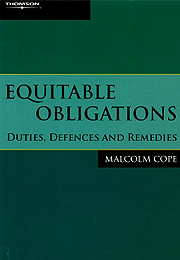From: (2008) 82 ALJ 282
Reviewed by PWY
It was somewhat exciting to see a new book on equitable principles especially in the light of the prediction by some restitutionalists that equity as a subject has really ceased to exist. However,
unfortunately, my excitement soon dissipated when I considered the text in detail. The work contains a large amount of detailed discussion on the law of trustees and fiduciaries, their duties and remedies for their breach. There is a lot of good material in the book. However, I get the feeling that the author would have been better advised to spend another year or so refining his thoughts and considering more Australian material. It is most odd that his discussion in Ch 3 on persons subject to fiduciary duties does not (unless the reference was so fleeting I have overlooked it) refer to the brilliant article by Justice McPherson on the subject in (1998) 72 ALJ 288.
The book seems to have been composed when the author was on sabbatical in London and was working in a library with a good, but not comprehensive selection of Australian books. (I know
because I worked there when preparing the second edition of Fisher & Lightwood). This may be the cause of the large number of strange references in the footnotes. I found it most irritating that the footnotes either give merely the media neutral citation of a reported case or cite an English case of a decade ago only as reported in Vol 2 or Vol 3 of WLR or All ER when readers will be referring to it in the authorised reports. However, this defect is unevenly spread.
Part of the problem with the book is that it endeavours to discuss the law of fiduciaries in Australia comparing perspectives from England, Canada and New Zealand. Canada has been over-influenced with thought from the United States, and has diverged from the law of most Commonwealth countries, England has, in some instances gone on a frolic of its own which has usually been followed in New Zealand. An Australian advocate who attempted to argue a case,
especially one who argued it in New South Wales or the High Court, on this basis would suffer acute embarrassment.
The classic example is the author’s treatment of exemplary damages in equity. There is a very
strong New South Wales Court of Appeal authority that this is contrary to principle. Indeed,
Heydon JA, now on the High Court, said in his judgment in that case (Harris v Digital Pulse Pty Ltd (2003) 56 NSWLR 298) that any step to adopt such a rule could only be taken in the High Court. However, the author, using the media neutral citation and ignoring the fact that it is reported in the official NSWLR (though he does acknowledge the FLR reference to the case in his table of cases) acknowledges that the majority of the New South Wales Court of Appeal so decided, but spends much more of his text extolling the dissenting judgment, an inconsistent New Zealand judgment and noting that those are more consistent with legislative provisions in the Corporations Act 2001 (Cth).
The book puts concepts in simple ways and this mostly is fine. However, sometimes this is at the
cost of ignoring contrary views. The most glaring example is the treatment of the decision of British & West Building Society v Mothew (for some reason only the Vol 2 reference is given in Ch 2 and the All ER reference is given in Ch 8 so that when one consults the index one can easily overlook half the references to the case). Although the author correctly says in Ch 8 that the High Court has yet to indicate a final view on Lord Millett’s basic approach in the case, his approach is rejected by many sound lawyers (though I should add this does not include myself). It would be nice to be told that the author’s view is probably the minority one. However, we are only told that in New Zealand the courts do not seem to worry about the difference between a fiduciary duty and common law negligence (a position rejected in Australia).
My verdict might be being reached through the spectacles of a New South Wales specialist in
equity and it may well be that other people may get more help from this volume than I have. If it does go into another edition in six years time or so, I hope that the author will build on the base of the material he has collected to make the work a more polished and comprehensive product than this first edition.



 Equity
Equity